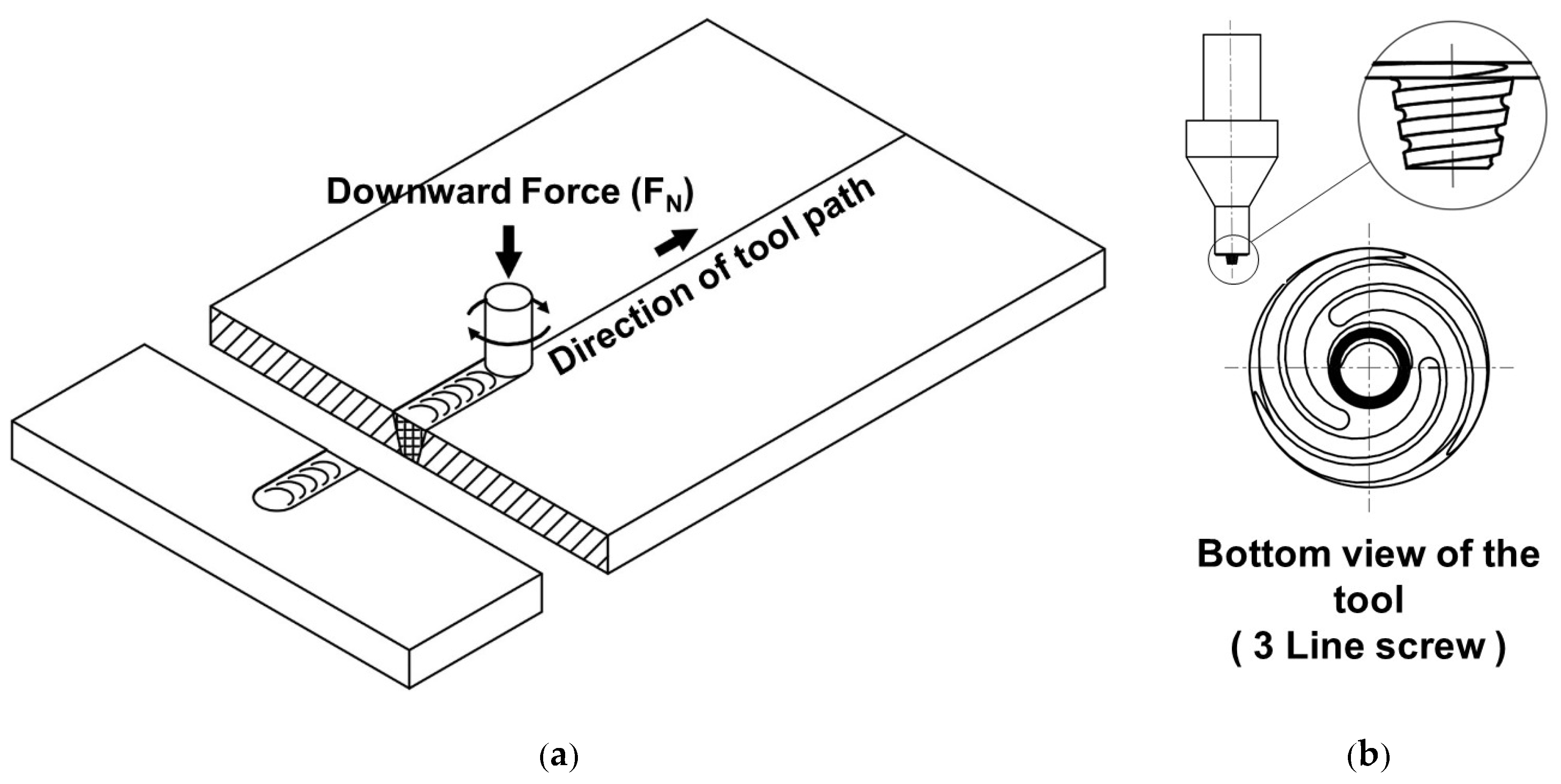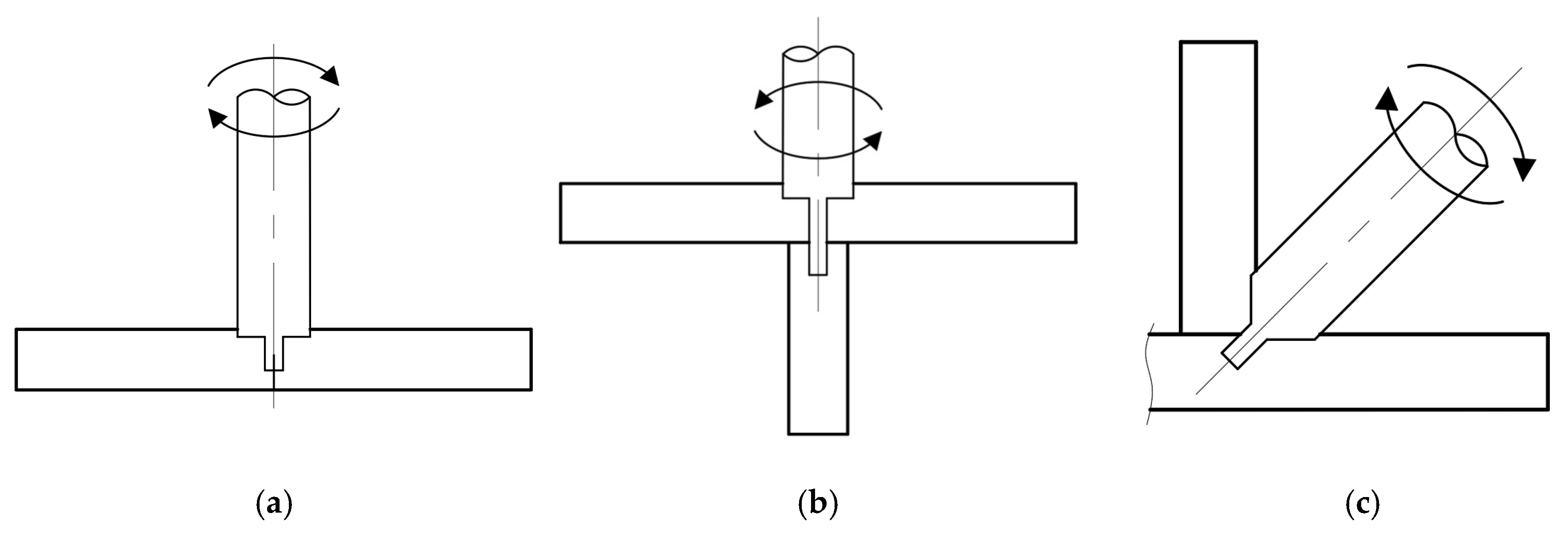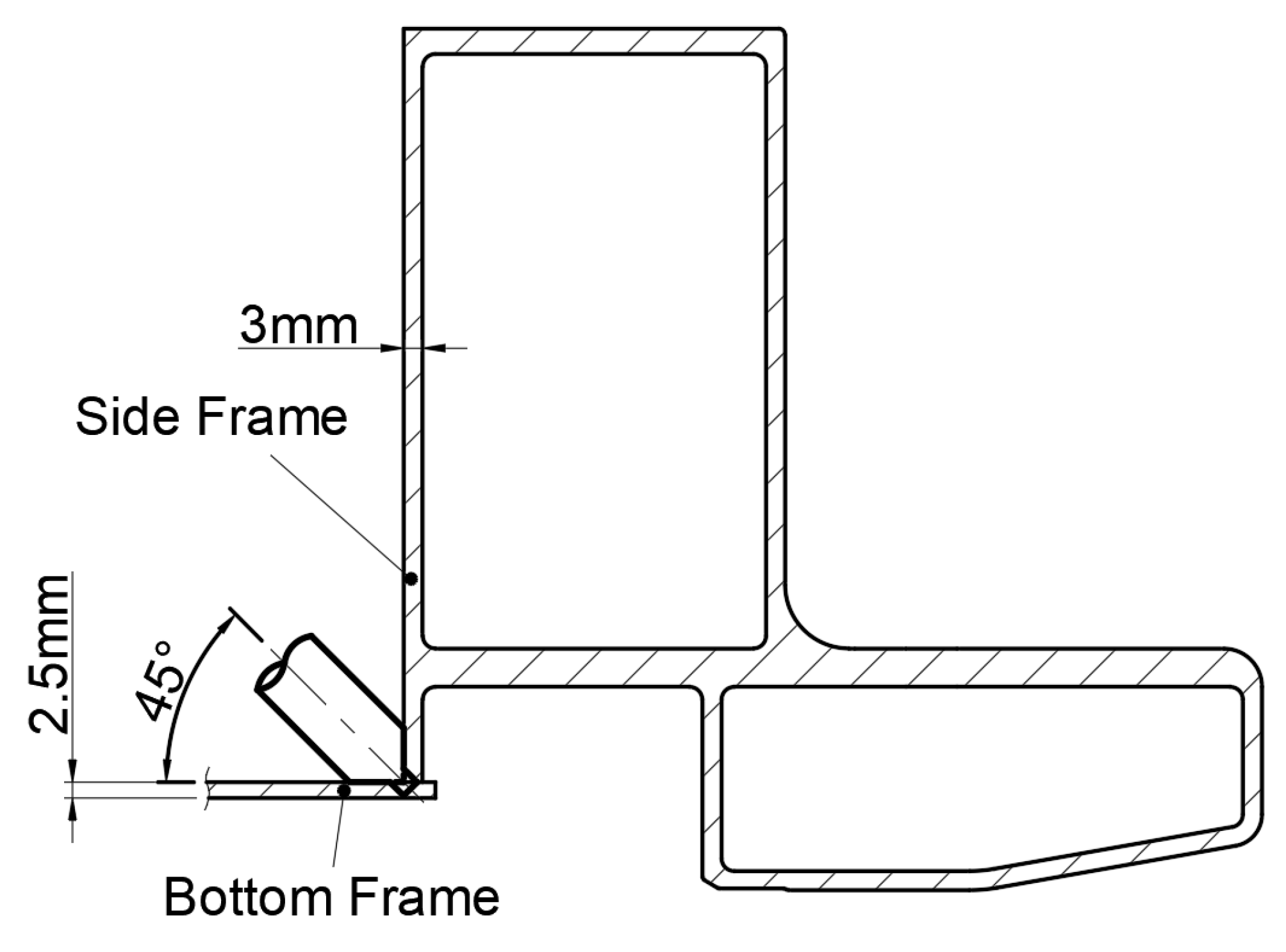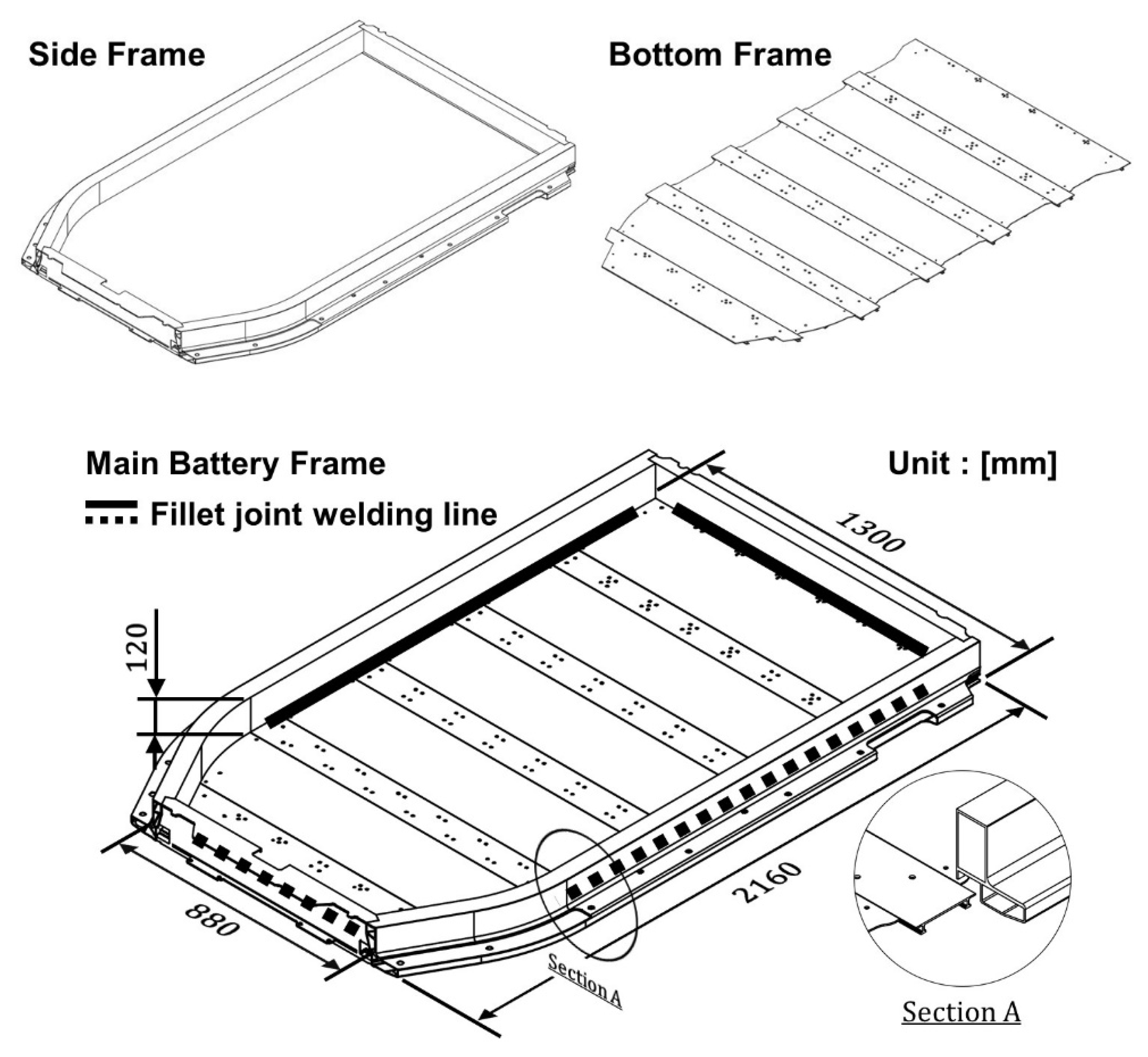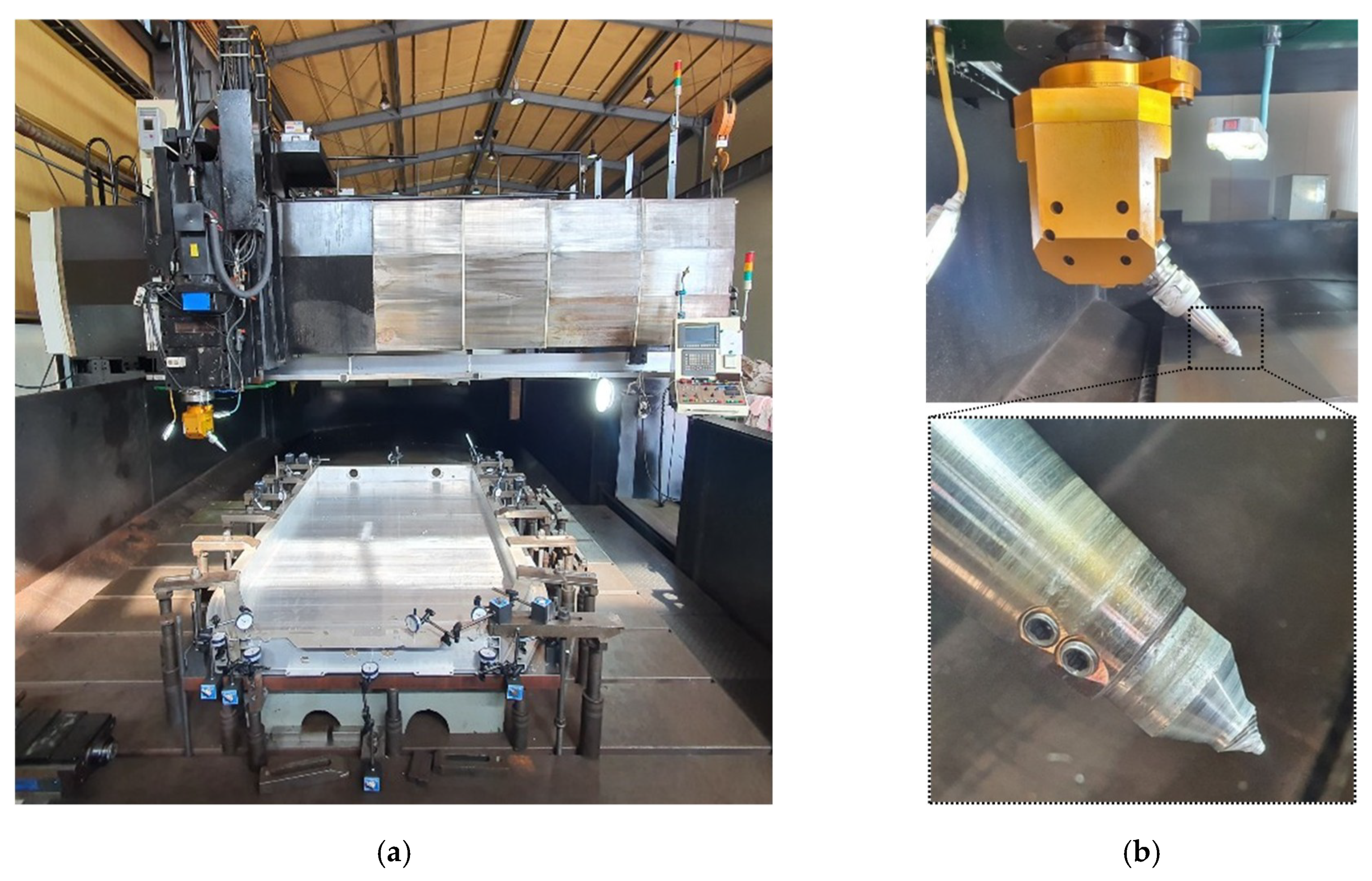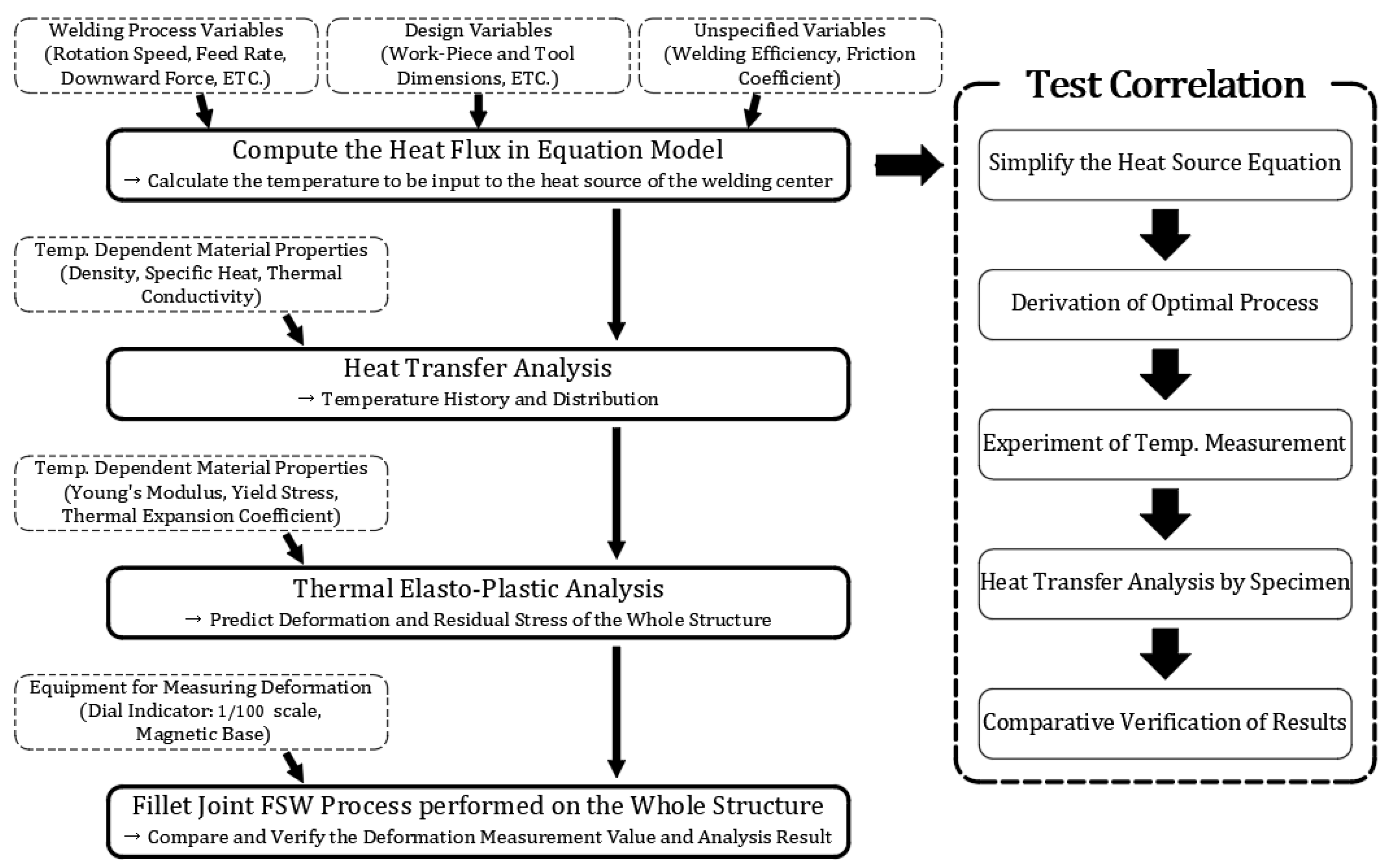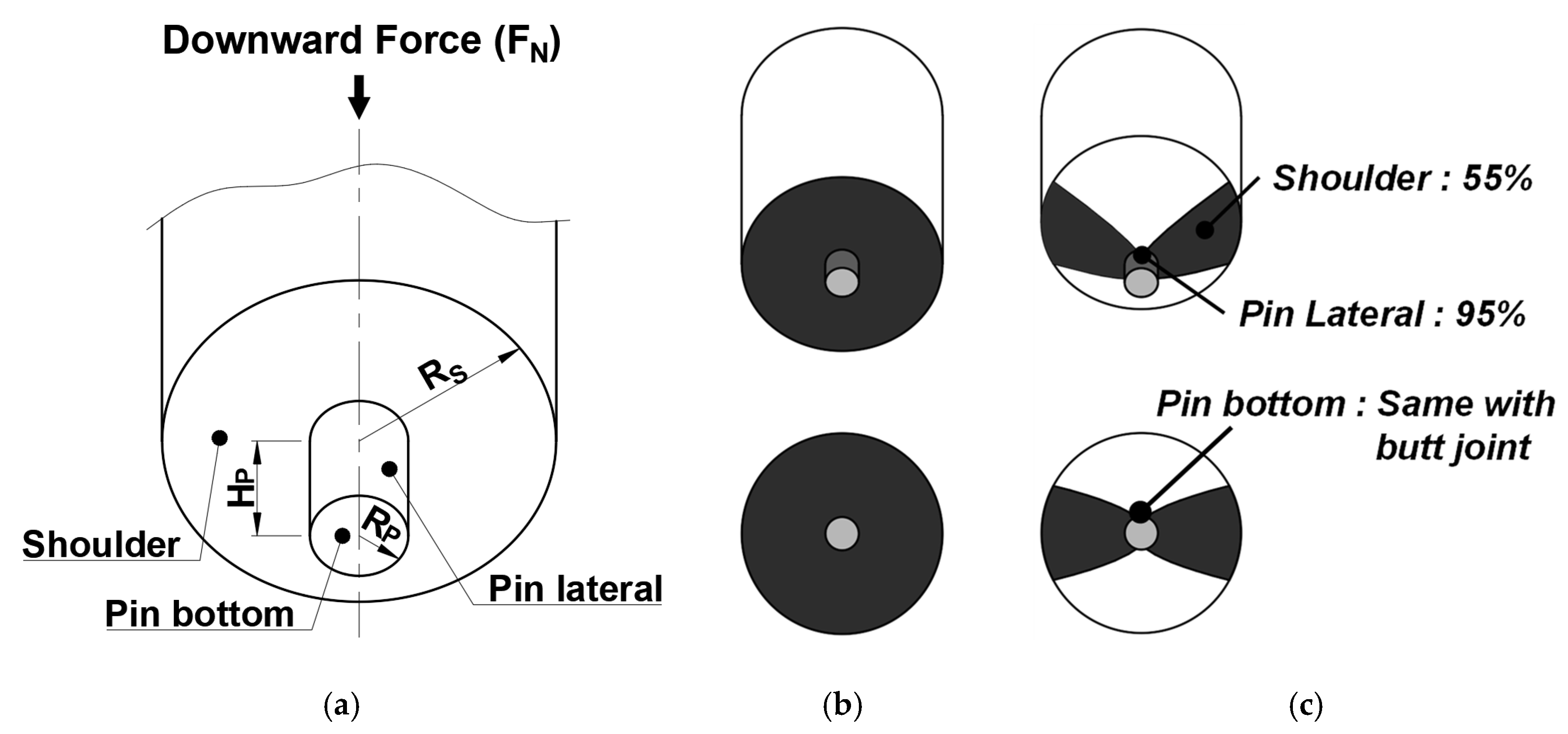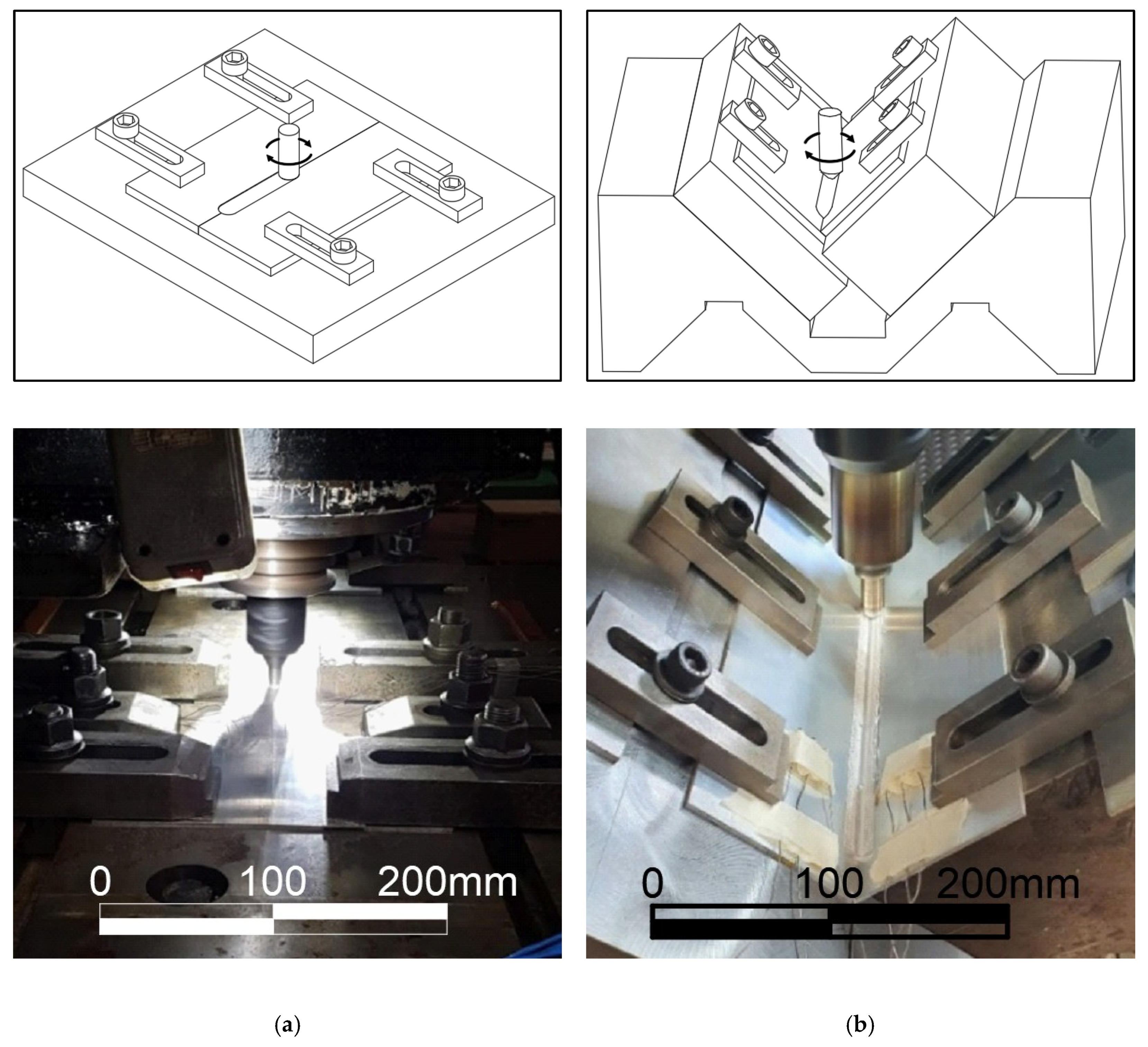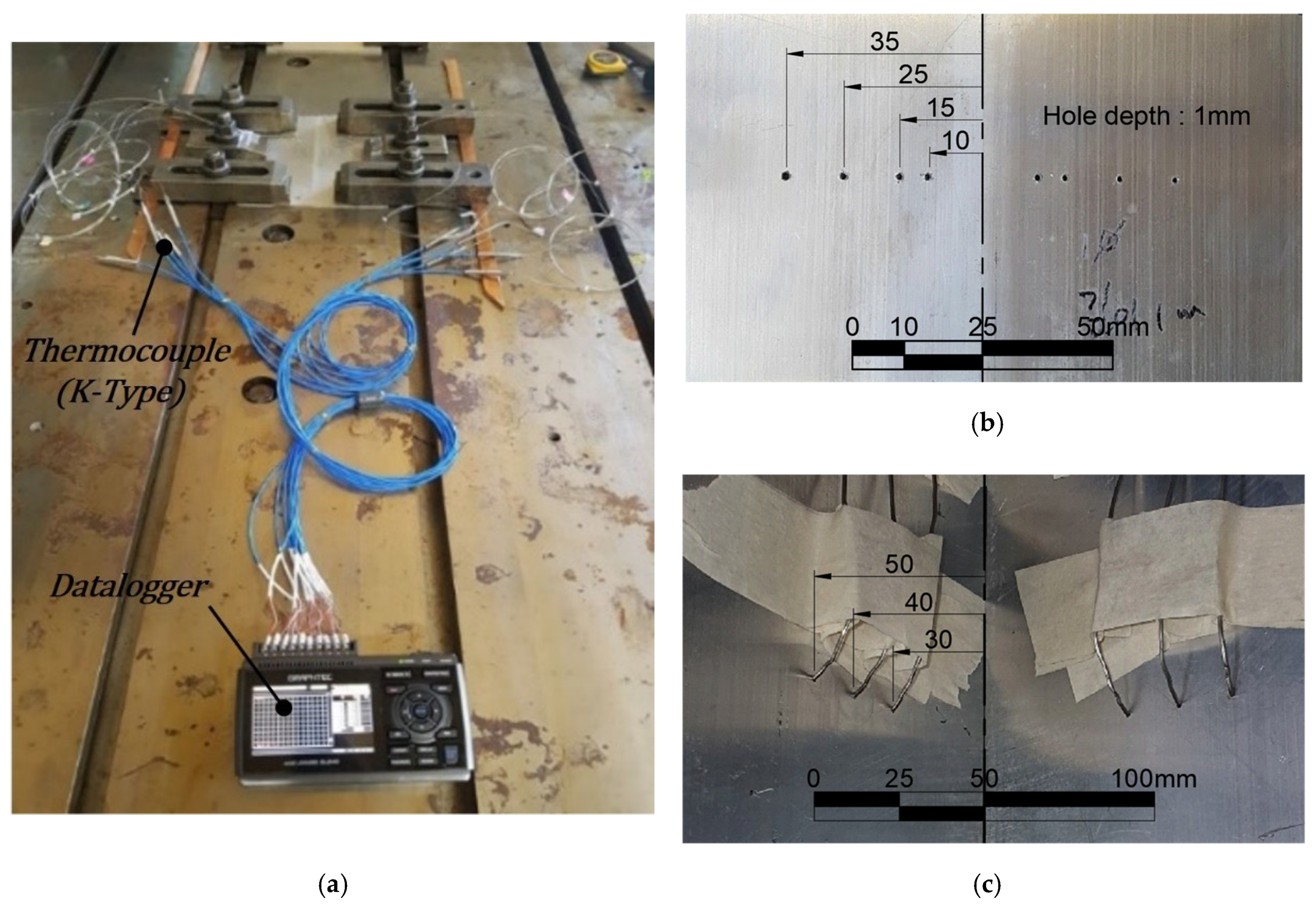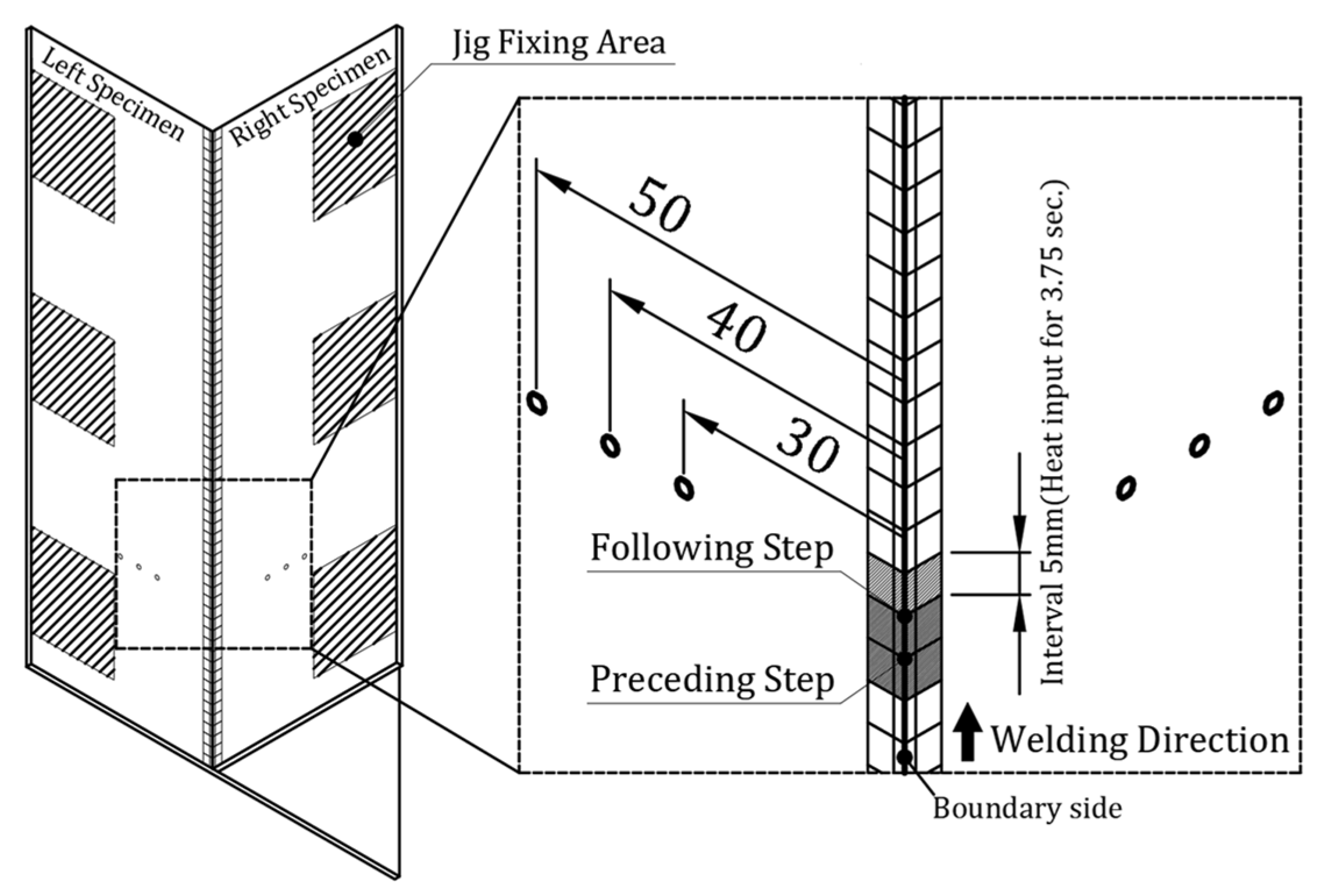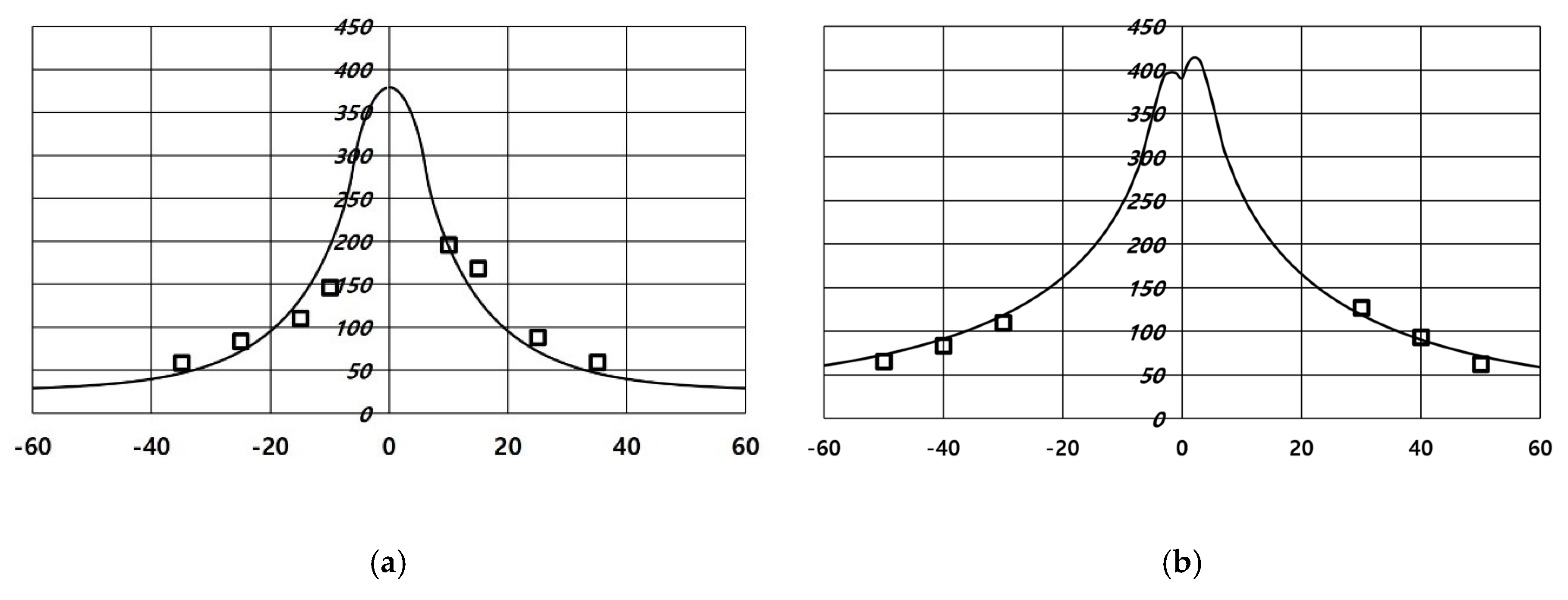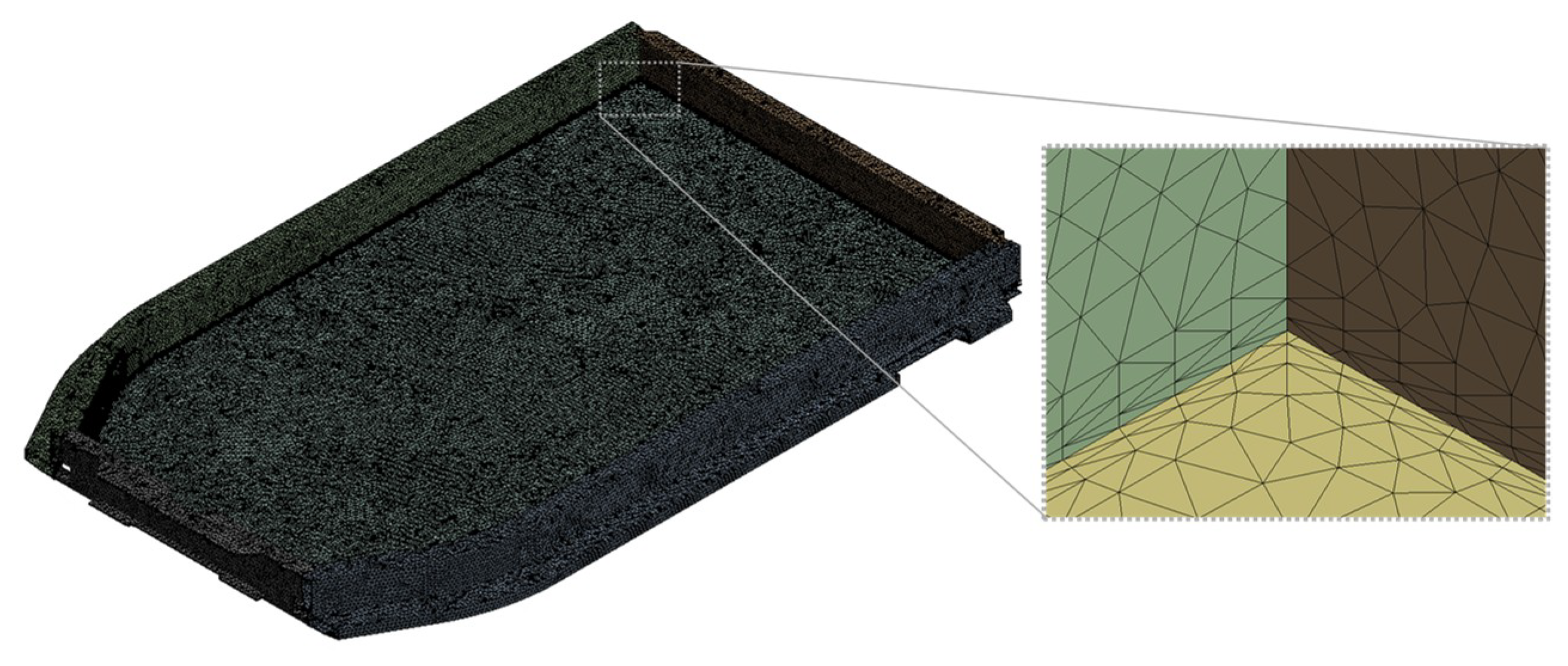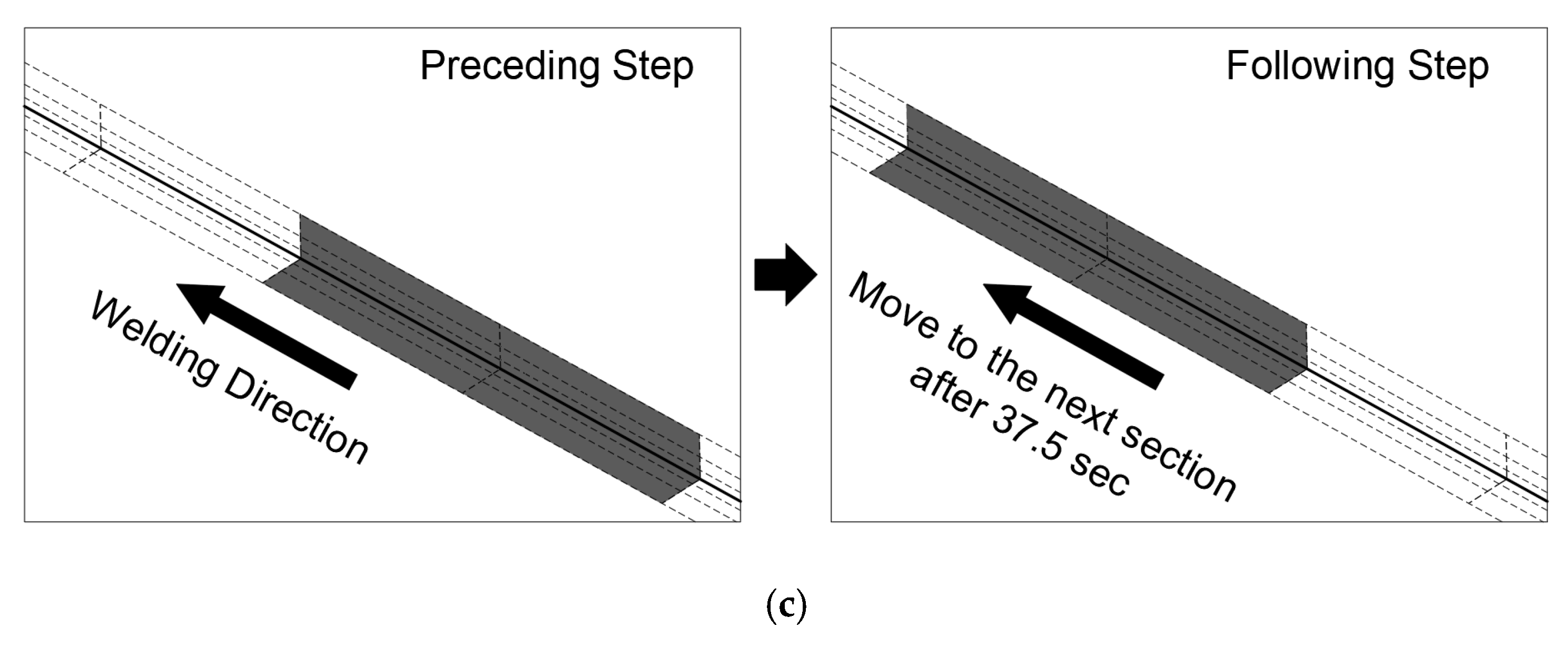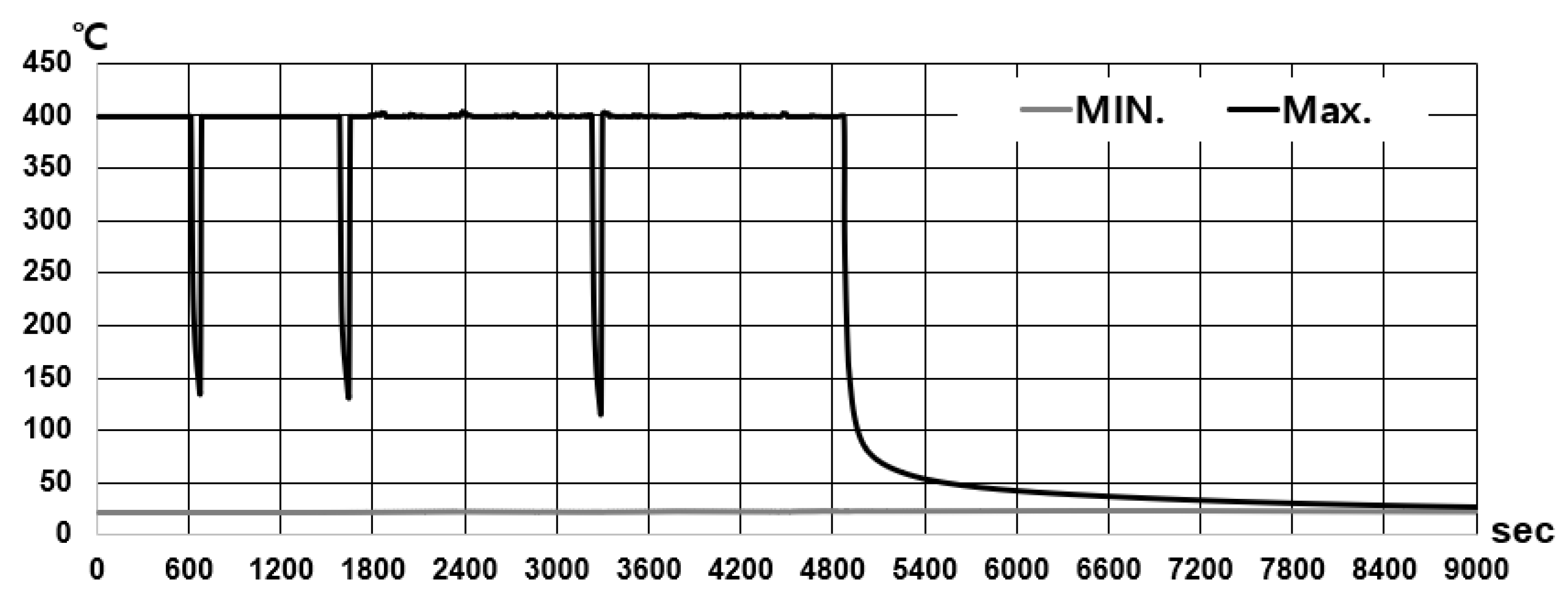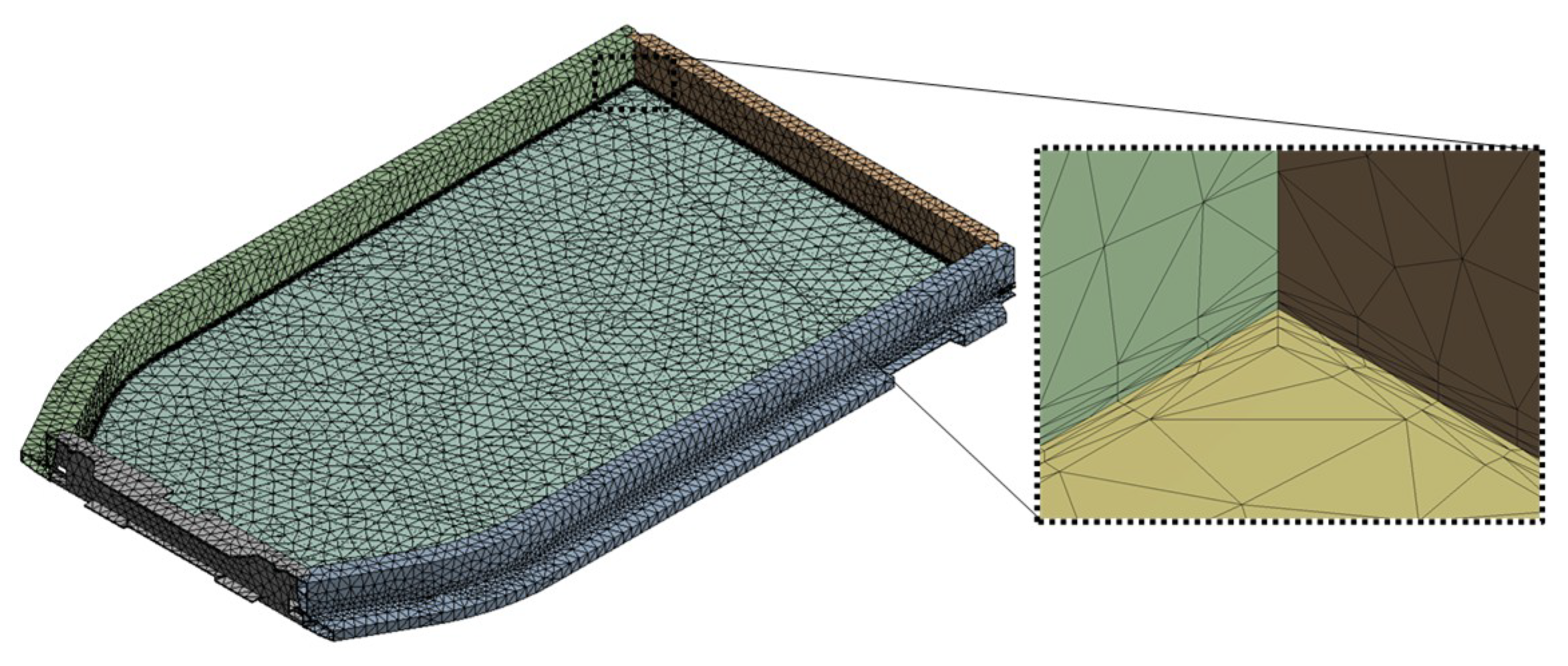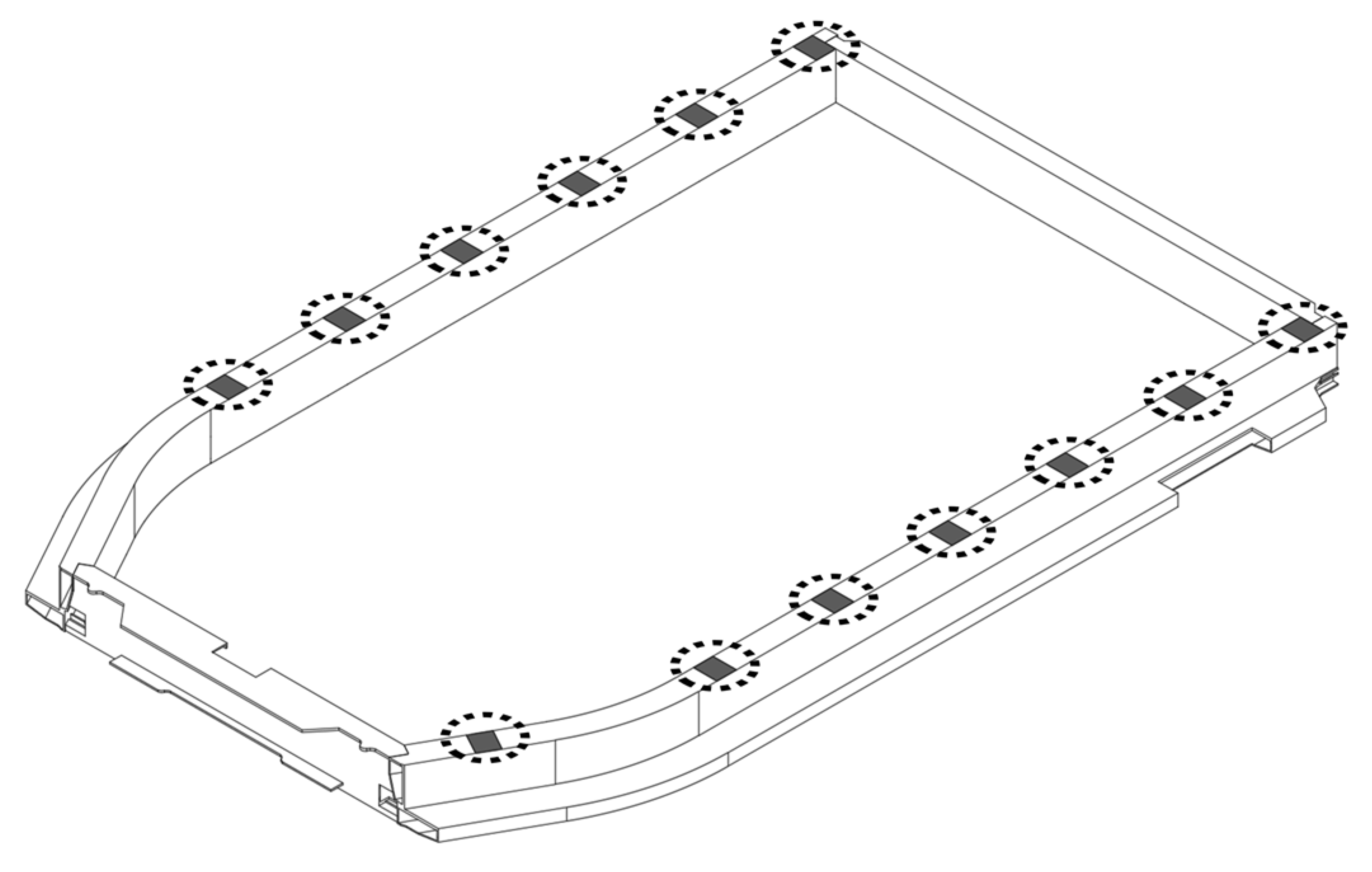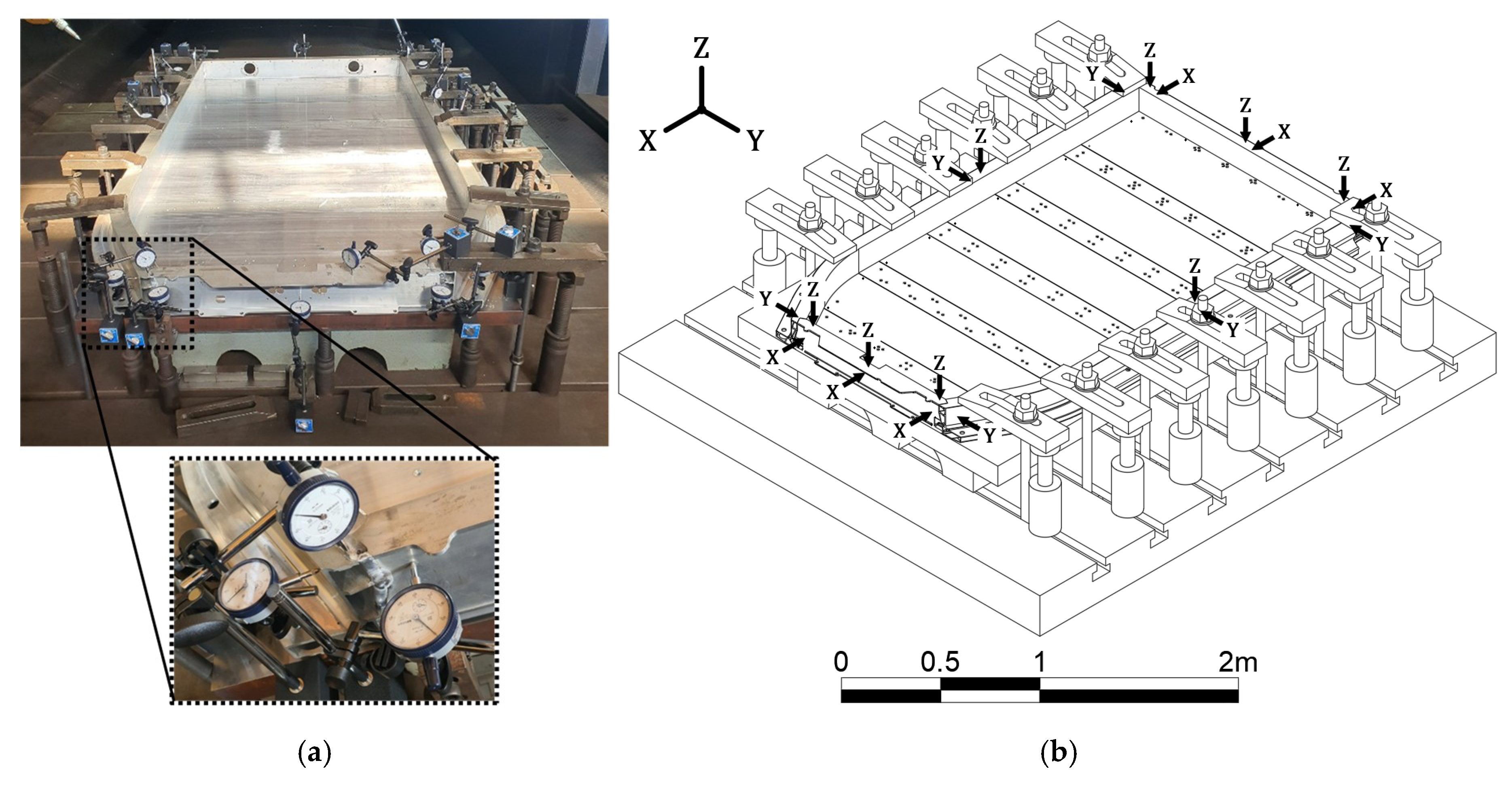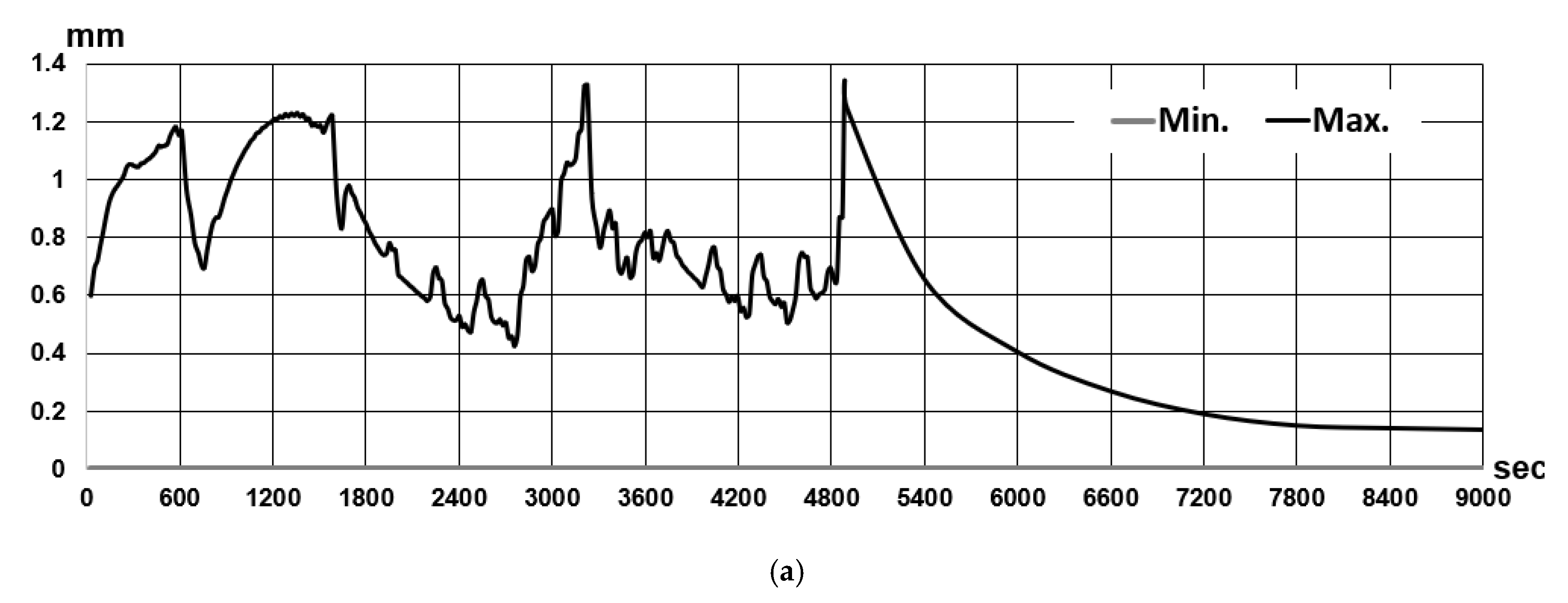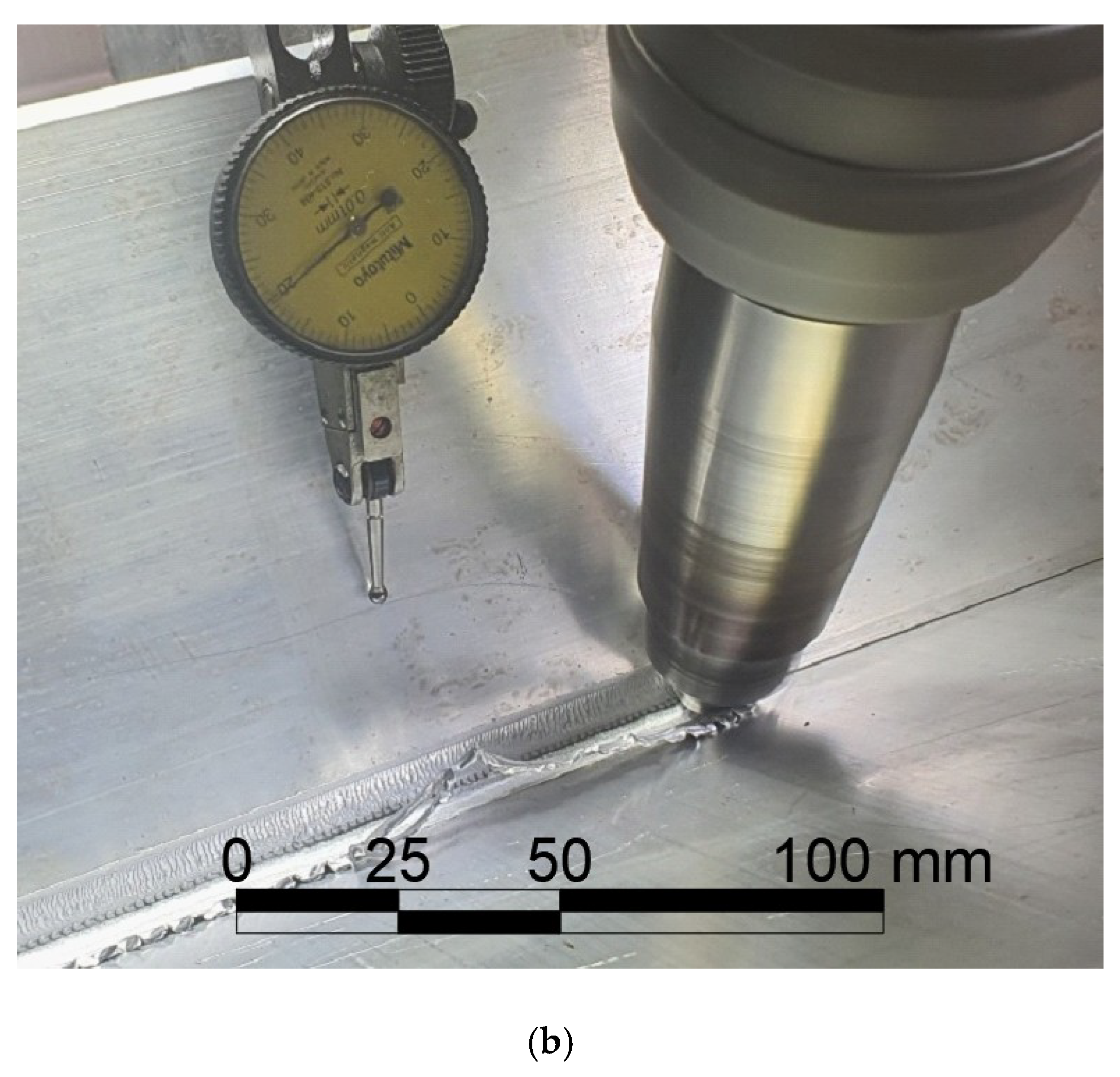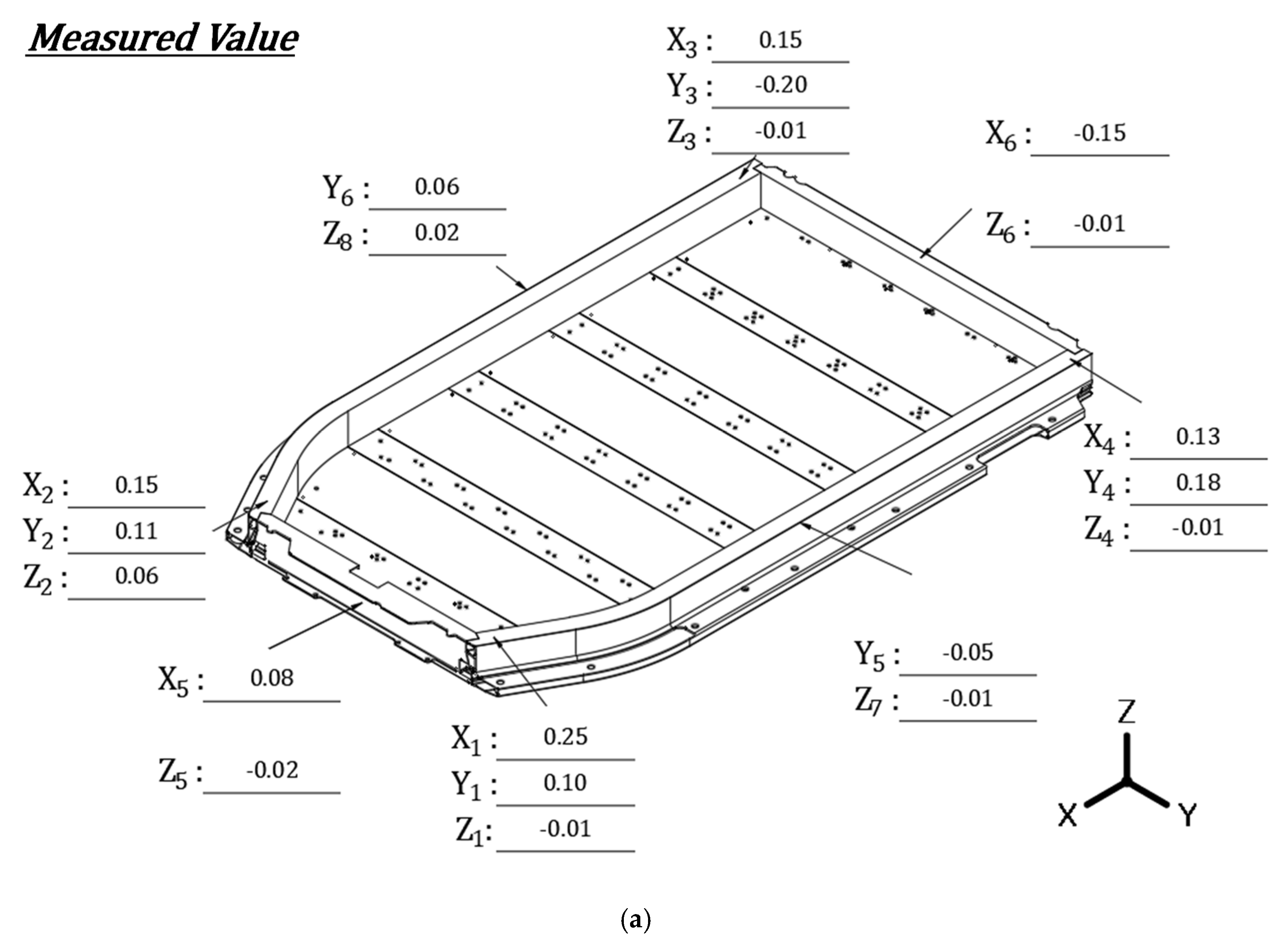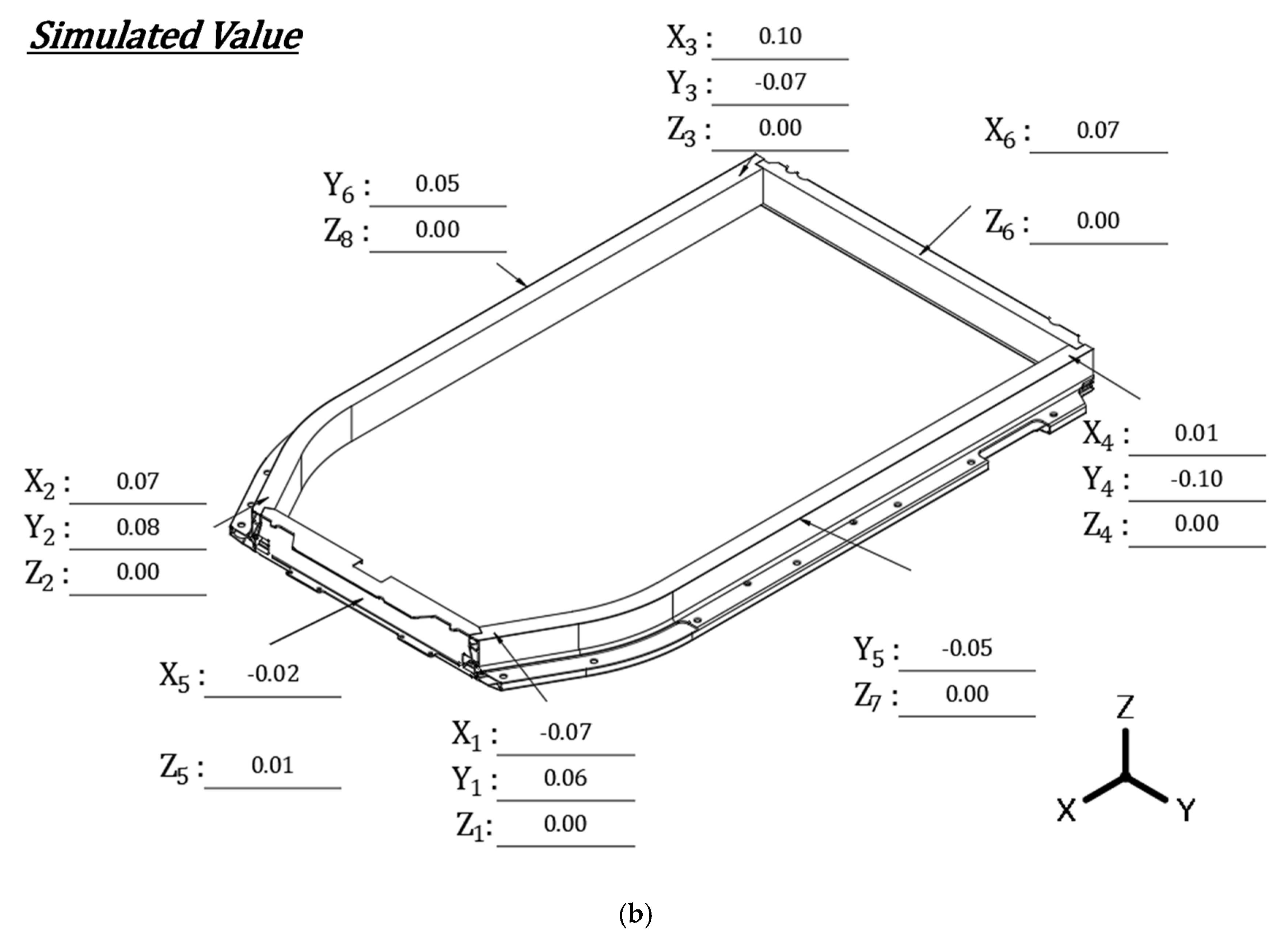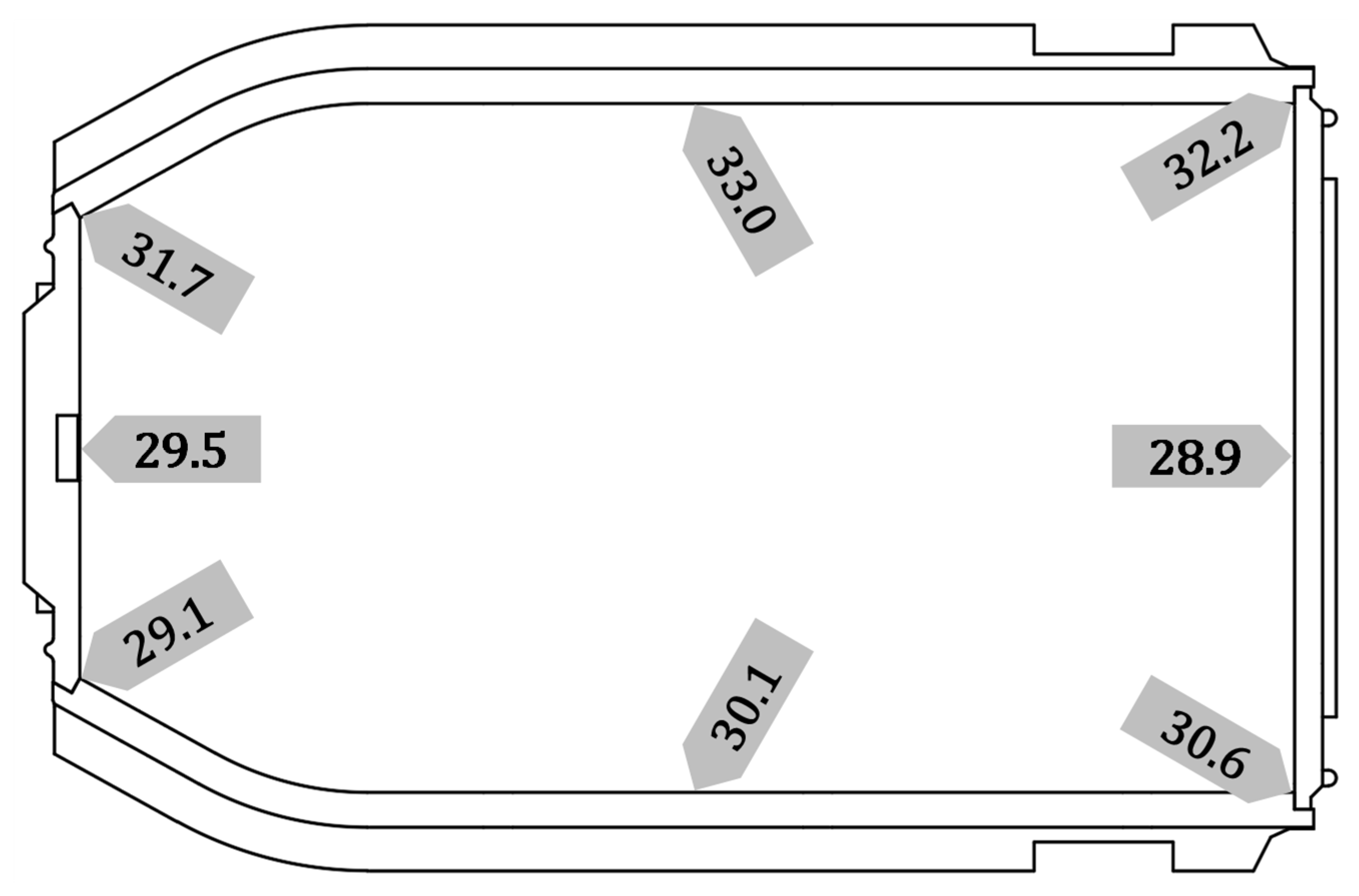Author Contributions
Conceptualization, S.K. and H.K.; methodology, S.K. and J.K.; software, C.L. and H.K.; validation, H.K. and Y.J.; formal analysis, S.K. and J.K.; investigation, H.K. and K.L.; resources, S.K. and K.L.; data curation, S.K.; writing—original draft preparation, S.K.; writing—review and editing, S.K. and K.L.; visualization, H.K.; supervision, S.K.; project administration, S.K.; funding acquisition, S.K. All authors have read and agreed to the published version of the manuscript.
Figure 1.
Principle of friction stir welding (FSW) process: (a) Description of FSW progress; (b) general design shape of FSW tool.
Figure 1.
Principle of friction stir welding (FSW) process: (a) Description of FSW progress; (b) general design shape of FSW tool.
Figure 2.
Types of FSW joint: (a) Butt FSW; (b) T-joint FSW; (c) fillet joint FSW.
Figure 2.
Types of FSW joint: (a) Butt FSW; (b) T-joint FSW; (c) fillet joint FSW.
Figure 3.
Application type of fillet joint FSW.
Figure 3.
Application type of fillet joint FSW.
Figure 4.
Full schematic diagram of fillet joint FSW for main battery frame.
Figure 4.
Full schematic diagram of fillet joint FSW for main battery frame.
Figure 5.
Fillet joint FSW equipment: (a) Actual full-frame structure set; (b) actual fillet FSW tool set.
Figure 5.
Fillet joint FSW equipment: (a) Actual full-frame structure set; (b) actual fillet FSW tool set.
Figure 6.
Flow chart of research procedure.
Figure 6.
Flow chart of research procedure.
Figure 7.
Area where frictional heat is generated by FSW method: (a) Major geometry of the tool; (b) friction area of tool in butt FSW; (c) friction area of tool in fillet joint FSW.
Figure 7.
Area where frictional heat is generated by FSW method: (a) Major geometry of the tool; (b) friction area of tool in butt FSW; (c) friction area of tool in fillet joint FSW.
Figure 8.
Experiment models: (a) Butt joint; (b) fillet joint.
Figure 8.
Experiment models: (a) Butt joint; (b) fillet joint.
Figure 9.
Experiment of temperature measurement: (a) Measuring equipment; (b) measuring point of butt FSW; (c) measuring point of fillet FSW.
Figure 9.
Experiment of temperature measurement: (a) Measuring equipment; (b) measuring point of butt FSW; (c) measuring point of fillet FSW.
Figure 10.
Pre-process of heat transfer analysis for the specimen unit.
Figure 10.
Pre-process of heat transfer analysis for the specimen unit.
Figure 11.
Heat transfer analysis results and experiment results: (a) Butt FSW; (b) fillet joint FSW.
Figure 11.
Heat transfer analysis results and experiment results: (a) Butt FSW; (b) fillet joint FSW.
Figure 12.
AL6063-T5 material properties required for heat transfer analysis: (a) Density; (b) specific heat; (c) thermal conductivity.
Figure 12.
AL6063-T5 material properties required for heat transfer analysis: (a) Density; (b) specific heat; (c) thermal conductivity.
Figure 13.
Simplify the design geometry of the full-frame structure.
Figure 13.
Simplify the design geometry of the full-frame structure.
Figure 14.
Mesh for heat transfer analysis.
Figure 14.
Mesh for heat transfer analysis.
Figure 15.
Pre-process of heat transfer analysis: (a) FSW sequence; (b) method to enter temperature in the welding center; (c) moving method of heat source.
Figure 15.
Pre-process of heat transfer analysis: (a) FSW sequence; (b) method to enter temperature in the welding center; (c) moving method of heat source.
Figure 16.
Temperature distribution history of the full-frame structure.
Figure 16.
Temperature distribution history of the full-frame structure.
Figure 17.
AL6063-T5 material properties required for thermal elasto-plastic analysis: (a) Coefficient of thermal expansion; (b) Young’s modulus; (c) yield stress.
Figure 17.
AL6063-T5 material properties required for thermal elasto-plastic analysis: (a) Coefficient of thermal expansion; (b) Young’s modulus; (c) yield stress.
Figure 18.
Mesh for thermal elasto-plastic analysis.
Figure 18.
Mesh for thermal elasto-plastic analysis.
Figure 19.
Temperature distribution history of the full-frame structure.
Figure 19.
Temperature distribution history of the full-frame structure.
Figure 20.
FSW deformation measurement of actual full-frame structural: (a) Position of dial indicator; (b) measurement direction of deformation.
Figure 20.
FSW deformation measurement of actual full-frame structural: (a) Position of dial indicator; (b) measurement direction of deformation.
Figure 21.
FSW deformation: (a) Deformation history result; (b) deformation measured during welding.
Figure 21.
FSW deformation: (a) Deformation history result; (b) deformation measured during welding.
Figure 22.
Comparative verification of FSW variant: (a) Measured values; (b) simulated values.
Figure 22.
Comparative verification of FSW variant: (a) Measured values; (b) simulated values.
Figure 23.
Stress distribution [unit: MPa].
Figure 23.
Stress distribution [unit: MPa].
Table 1.
Design variables for heat source calculation.
Table 1.
Design variables for heat source calculation.
| Design Parameter | Butt Joint Contact Area | Fillet Joint Contact Area | Ratio |
|---|
| Shoulder | 106.0 mm2 | 58.7 mm2 | 55% |
| Pin Lateral | 28.3 mm2 | 27.0 mm2 | 95% |
| Pin Bottom | 7.1 mm2 | 7.1 mm2 | 100% |
| Total | 141.4 mm2 | 92.8 mm2 | 66% |
Table 2.
Design variables for heat source calculation.
Table 2.
Design variables for heat source calculation.
| Symbol | Unit | Description | Symbol | Unit | Description |
|---|
| Qt | W/mm2 | Total Heat Flux | ω | rad/sec | Rotation Speed |
| RS | mm | Radius of Tool Shoulder | η | - | Welding Efficiency |
| RP | mm | Radius of Tool Pin | μ | - | Friction Coefficient |
| HP | Mm | Height of Tool Pin | τ | Pa | Shear Stress |
| FN | N | Downward Force | P | Pa | Normal Pressure |
Table 3.
Test conditions of butt FSW process.
Table 3.
Test conditions of butt FSW process.
| | mm/min | 600 | 700 | 800 | 900 | 1000 |
|---|
| RPM | |
|---|
| 1600 | #1 | #2 | #3 | #4 | #5 |
| 1800 | #6 | #7 | #8 | #9 | #10 |
| 2000 | #11 | #12 | #13 | #14 | #15 |
| 2200 | #16 | #17 | #18 | #19 | #20 |
| 2400 | #21 | #22 | #23 | #24 | #25 |
Table 4.
Test conditions of fillet FSW process.
Table 4.
Test conditions of fillet FSW process.
| | mm/min | 40 | 60 | 80 |
|---|
| RPM | |
|---|
| 1000 | #1 | #2 | #3 |
| 1200 | #4 | #5 | #6 |
| 1400 | #7 | #8 | #9 |
Table 5.
Optimal process condition.
Table 5.
Optimal process condition.
| Process Condition | Unit | Butt FSW | Fillet Joint FSW |
|---|
| Rotation Speed | RPM | 2000 | 1200 |
| Welding Speed | mm/min | 1000 | 80 |
Table 6.
Comparison of maximum displacements in x-direction [mm].
Table 6.
Comparison of maximum displacements in x-direction [mm].
| Item | Unit | Measuring Point |
|---|
| Distance | mm | −35 | −25 | −15 | −10 | 10 | 15 | 25 | 35 |
|---|
| Experiment | °C | 58.3 | 84.1 | 110.7 | 146.1 | 196.1 | 168.3 | 88.3 | 59.1 |
| Analysis | 46.8 | 72.2 | 132.6 | 194.2 | 194.2 | 132.6 | 72.2 | 46.8 |
| Deviation | % | 19.8 | 14.2 | −19.8 | −32.9 | 1.0 | 21.2 | 18.3 | 20.9 |
Table 7.
Comparison of maximum displacements in y-direction [mm].
Table 7.
Comparison of maximum displacements in y-direction [mm].
| Item | Unit | Measuring Point |
|---|
| Distance | mm | −50 | −40 | −30 | −30 | 40 | 50 |
|---|
| Experiment | °C | 58.3 | 84.1 | 110.7 | 146.1 | 196.1 | 168.3 |
| Analysis | 46.8 | 72.2 | 132.6 | 194.2 | 194.2 | 132.6 |
| Deviation | % | 19.8 | 14.2 | −19.8 | −32.9 | 1.0 | 21.2 |
Table 8.
Mesh properties for heat transfer analysis.
Table 8.
Mesh properties for heat transfer analysis.
| Method | Tetrahedrons |
|---|
| Element Size | 10 mm |
| Element Shape | Triangle |
| Number of Nodes | 142,129 |
| Number of Elements | 440,287 |
Table 9.
Temperature to enter into full structure analysis.
Table 9.
Temperature to enter into full structure analysis.
| Item | Unit | Range from Welding Center Line |
|---|
| Distance | mm | −10 | −5 | −2 | 2 | 5 | 10 |
|---|
| Temp. derived from the specimen | °C | 323 | 396 | 410 | 408 | 382 | 390 |
| Temp. to enter into the simulation | 315 | 390 | 410 | 410 | 390 | 315 |
Table 10.
Mesh properties for thermal elasto-plastic analysis.
Table 10.
Mesh properties for thermal elasto-plastic analysis.
| Method | Tetrahedrons |
|---|
| Element Size | Side Frame | 30 mm |
| Bottom Frame | 40 mm |
| Element Shape | Triangle |
| Number of Nodes | 128,986 |
| Number of Elements | 67,847 |
Table 11.
Comparison of variation between measured and experimental values [unit: mm].
Table 11.
Comparison of variation between measured and experimental values [unit: mm].
| | | Measured Value | Simulated Value | Mean Deviation |
|---|
| X | X1 | 0.25 | 0.07 | 0.08 |
| X2 | 0.15 | 0.07 |
| X3 | 0.15 | 0.10 |
| X4 | 0.13 | 0.10 |
| X5 | 0.08 | 0.02 |
| X6 | 0.15 | 0.07 |
| Y | Y1 | 0.10 | 0.06 | 0.05 |
| Y2 | 0.11 | 0.08 |
| Y3 | 0.20 | 0.07 |
| Y4 | 0.18 | 0.10 |
| Y5 | 0.05 | 0.05 |
| Y6 | 0.06 | 0.05 |
| Z | Z1 | 0.01 | 0.00 | 0.02 |
| Z2 | 0.06 | 0.00 |
| Z3 | 0.01 | 0.00 |
| Z4 | 0.01 | 0.00 |
| Z5 | 0.02 | 0.01 |
| Z6 | 0.01 | 0.00 |
| Z7 | 0.01 | 0.00 |
| Z8 | 0.02 | 0.00 |
